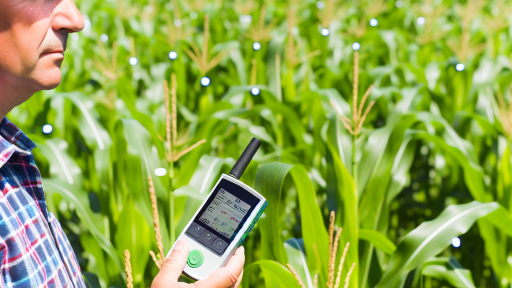Introduction to CRISPR Technology
Definition of CRISPR Technology
CRISPR technology stands for Clustered Regularly Interspaced Short Palindromic Repeats.
This innovative gene-editing technique allows precise modifications in DNA sequences.
It utilizes a natural defense mechanism found in bacteria to target specific genes.
Research teams have leveraged this mechanism for various applications in agriculture.
Historical Context
CRISPR’s discovery dates back to the late 1980s when scientists first identified its DNA sequences.
Initially, researchers observed these sequences in the genomes of bacteria.
By 2012, scientists Jennifer Doudna and Emmanuelle Charpentier developed the first CRISPR-based gene-editing system.
Since then, the technology has gained immense popularity in various scientific fields.
The Moving Parts of CRISPR Technology
The CRISPR system consists of two main components: the guide RNA and the Cas9 protein.
The guide RNA directs the Cas9 protein to the specific location in the DNA.
Once it binds, Cas9 creates a double-strand break in the DNA.
This interruption allows for either gene disruption or the introduction of new genetic material.
Applications in Agriculture
Farmers and scientists are exploring CRISPR to enhance crop resilience and productivity.
It can potentially reduce the need for chemical pesticides and fertilizers.
Furthermore, CRISPR technologies hold promise in developing climate-resilient crops.
Transform Your Agribusiness
Unlock your farm's potential with expert advice tailored to your needs. Get actionable steps that drive real results.
Get StartedThis gene-editing tool may also help in creating more nutritious food sources.
Ethical Considerations
The use of CRISPR technology raises several ethical concerns in agriculture.
Questions regarding food safety and environmental impacts are prevalent.
Regulatory bodies worldwide are examining how to govern its safe applications.
Dialogue continues among scientists, policymakers, and the public to address these issues.
How CRISPR Works
The Basics of Gene Editing
CRISPR technology utilizes a natural defense mechanism in bacteria.
This mechanism protects bacteria from viruses by cutting their DNA.
Scientists have adapted this system for gene editing in other organisms.
CRISPR stands for Clustered Regularly Interspaced Short Palindromic Repeats.
This system includes two main components: guide RNA and Cas9 enzyme.
Guide RNA directs the Cas9 enzyme to specific DNA sequences.
Cas9 acts like molecular scissors, cutting the targeted DNA strands.
How CRISPR Targets Genes
First, researchers design guide RNA to match the DNA sequence of interest.
Next, they introduce this guide RNA and the Cas9 enzyme into the cells.
Once inside, the guide RNA binds to the target DNA sequence.
Then, the Cas9 enzyme cuts the DNA at the designated location.
After cutting, the cell attempts to repair the DNA break.
This repair process can introduce changes to the genetic code.
Potential Applications in Agriculture
CRISPR offers promising applications in sustainable agriculture.
For example, it can develop crops resistant to pests and diseases.
Moreover, it helps enhance crop yield and nutritional value.
This technology can reduce the need for chemical pesticides.
Consequently, it supports environmentally friendly farming practices.
Challenges and Considerations
Despite its advantages, CRISPR technology faces challenges.
Showcase Your Farming Business
Publish your professional farming services profile on our blog for a one-time fee of $200 and reach a dedicated audience of farmers and agribusiness owners.
Publish Your ProfileOne major issue is the potential for off-target effects.
This occurs when the Cas9 enzyme cuts unintended DNA sequences.
Additionally, regulatory frameworks for CRISPR-modified organisms remain unclear.
Public perception of gene editing also influences its adoption.
Researchers must address ethical and safety concerns proactively.
Applications of CRISPR in Agriculture
Crop Improvement
CRISPR technology revolutionizes crop improvement techniques.
This method allows precision editing of plant genomes.
Farmers can develop crops with enhanced traits much faster.
For instance, scientists can create drought-resistant varieties.
Additionally, CRISPR enhances nutritional content in crops.
Examples include rice enriched with vitamins and minerals.
Moreover, the technology reduces dependence on chemical fertilizers.
It also minimizes the need for pesticide applications.
As a result, farmers can produce healthier and more sustainable food.
Disease Resistance
Disease resistance is another significant application of CRISPR.
This technology enables crops to withstand various pathogens.
Scientists utilize CRISPR to edit genes associated with susceptibility.
Consequently, crops can exhibit improved resilience to diseases.
For example, researchers targeted the rice blast fungus.
They successfully developed rice varieties with higher resistance.
Such improvements result in reduced crop losses each season.
Furthermore, maintaining genetic diversity ensures long-term sustainability.
Farmers benefit greatly from disease-resistant plants, enhancing yields.
CRISPR significantly advances agricultural practices for the future.
Explore Further: Advanced Soil Health Monitoring Technologies for Sustainable Agriculture
Benefits of Using CRISPR in Farming
Enhancing Yield
CRISPR technology significantly boosts crop yields.
Farmers can genetically modify plants for optimal growth.
This method increases resistance to pests and diseases.
As a result, farmers enjoy abundant harvests each season.
Higher yields improve food security globally.
Promoting Sustainability
CRISPR contributes to more sustainable farming practices.
It reduces the need for chemical fertilizers and pesticides.
Consequently, environmental degradation diminishes over time.
This method encourages biodiversity in agricultural ecosystems.
Moreover, it enables crops to adapt to climate change efficiently.
Improving Cost-Effectiveness
Using CRISPR reduces production costs for farmers.
Enhanced crop resilience leads to lower losses.
Farmers save on pest and disease management expenses.
This technology also increases profitability in the long run.
Ultimately, consumers benefit from lower food prices.
Showcase Your Farming Business
Publish your professional farming services profile on our blog for a one-time fee of $200 and reach a dedicated audience of farmers and agribusiness owners.
Publish Your ProfileLearn More: Farm Management Software: Streamlining Daily Farming Operations
Ethical Considerations and Regulations Surrounding CRISPR Technology
Introduction to Ethical Issues
CRISPR technology raises significant ethical questions in agriculture.
Many stakeholders express concerns about its implications for biodiversity.
Additionally, the potential effects on traditional farming practices draw attention.
Public Perception and Acceptance
Public perception plays a crucial role in the acceptance of CRISPR.
Many individuals worry about genetically modified organisms (GMOs).
Transparency in how CRISPR is used can alleviate some concerns.
Engaging with communities fosters understanding and trust.
Regulatory Frameworks
Various countries are developing regulatory frameworks for CRISPR use.
The European Union has strict regulations governing gene editing.
In contrast, the United States adopts a more lenient approach.
Clear guidelines ensure safety and effectiveness in agricultural applications.
Case Studies of Regulatory Implementation
Case studies illustrate different regulatory approaches globally.
For instance, Argentina embraces CRISPR technology for agricultural benefits.
The country’s regulations aim to promote innovation while ensuring safety.
In comparison, the EU’s cautious stance limits CRISPR applications.
Future Ethical Considerations
As CRISPR evolves, new ethical challenges may arise.
Future technologies could further complicate regulatory decisions.
Ethics committees must adapt to changing scientific landscapes.
Ongoing dialogue among scientists, policymakers, and the public remains vital.
Find Out More: Implementing Controlled Environment Agriculture on Your Farm

Case Studies: Successful Implementation of CRISPR in Agricultural Practices
Enhancing Crop Resistance
Researchers at GreenFarm Innovations used CRISPR to create drought-resistant wheat.
This variety thrives in arid conditions, ensuring higher yields for farmers.
Consequently, the project demonstrated significant reductions in water usage.
Improving Nutritional Content
NutriCrop Solutions enhanced the vitamin A content of rice through CRISPR technology.
This fortified rice provides essential nutrients for populations facing malnutrition.
As a result, communities have experienced improved public health outcomes.
Reducing Pesticide Usage
BioAgriTech implemented CRISPR to develop pest-resistant soybeans.
This approach decreased the need for chemical pesticides significantly.
Farmers reported increased profitability while promoting environmental sustainability.
Increasing Yield Efficiency
Agrigen Corp successfully utilized CRISPR to improve tomato yield efficiency.
They developed a variety that matures faster with enhanced growth traits.
Farmers benefited from increased marketable produce in a shorter time frame.
Regulatory Considerations
Regulatory frameworks evolve to accommodate CRISPR technology in agriculture.
Appropriate guidelines ensure the safe use of gene editing in crops.
Stakeholders are working together to establish clear and effective regulations.
Future Perspectives
The future of agriculture looks promising with CRISPR technology.
Ongoing research continues to explore new applications for gene editing.
Ultimately, this innovation could revolutionize food production globally.
Delve into the Subject: Sustainable Harvesting Techniques Leveraging Advanced Technologies
Showcase Your Farming Business
Publish your professional farming services profile on our blog for a one-time fee of $200 and reach a dedicated audience of farmers and agribusiness owners.
Publish Your ProfileChallenges and Limitations of CRISPR in Agriculture
Regulatory Hurdles
CRISPR technology faces significant regulatory challenges worldwide.
Governments are still determining how to classify genetically modified organisms.
This uncertainty slows down the approval process for new CRISPR-based crops.
Additionally, differing regulations exist across countries.
As a result, companies must navigate a complex landscape to launch products.
Public Perception
Public perception of genetic engineering remains a major hurdle for CRISPR adoption.
Many consumers express concerns about the safety of genetically modified foods.
This skepticism can lead to resistance against CRISPR-utilizing products.
Educating the public on CRISPR’s benefits is crucial for its acceptance.
Technical Limitations
Despite its advancements, CRISPR technology has technical limitations.
Off-target effects may unintentionally alter unrelated genes.
This raises safety concerns and questions about the technology’s reliability.
Moreover, the delivery mechanism of CRISPR components can complicate applications.
Enhancing precision and efficiency is essential for wider agricultural use.
Ethical Considerations
Ethical discussions surrounding CRISPR technology are increasingly relevant.
The potential for unforeseen ecological consequences raises alarms.
Some worry about creating unanticipated traits in plants or animals.
Such ethical dilemmas could influence future research and development.
Economic Factors
Economic challenges also play a role in CRISPR implementation in agriculture.
Developing CRISPR-based crops can require significant investment.
Smaller farmers may struggle to afford such innovations.
Therefore, broader access to CRISPR technology is essential for its success.
Future Prospects: The Role of CRISPR in Global Food Security
Enhancing Crop Resilience
CRISPR technology significantly improves crop resilience against pests and diseases.
This innovation allows for rapid development of disease-resistant varieties.
Farmers can rely on stronger plants that require fewer chemical inputs.
As a result, global food production can increase sustainably.
Boosting Nutritional Value
CRISPR enables the fortification of crops with essential nutrients.
This advancement addresses widespread nutritional deficiencies in many populations.
For instance, biofortified rice can provide vital vitamins and minerals.
Such improvements can have profound impacts on public health worldwide.
Facilitating Climate Adaptation
Climate change poses a significant threat to global agriculture.
CRISPR can help develop crops that thrive in changing conditions.
Examples include drought-tolerant and heat-resistant varieties.
These adaptations ensure food supply stability under adverse environmental stresses.
Expanding Agricultural Productivity
CRISPR technology streamlines the breeding process for higher yields.
Farmers can cultivate crops with improved growth rates and output.
Increased productivity raises farmers’ income and food availability.
This is critical for supporting a growing global population.
Addressing Regulatory Concerns
Regulations surrounding biotechnology remain a challenge for CRISPR adoption.
Producers must navigate complex legal frameworks and safety assessments.
Showcase Your Farming Business
Publish your professional farming services profile on our blog for a one-time fee of $200 and reach a dedicated audience of farmers and agribusiness owners.
Publish Your ProfileHowever, ongoing dialogue and research can lead to clearer guidelines.
These efforts will foster public trust and expand CRISPR applications.
Engaging with Ethical Considerations
As with any technology, ethical questions arise with CRISPR use in agriculture.
Concerns about biodiversity and environmental impacts must be addressed.
Transparent conversations about risks and benefits are essential.
This engagement can guide responsible CRISPR utilization in food systems.
Collaboration Across Sectors
Successful integration of CRISPR into agriculture requires collaboration.
Partnerships among scientists, farmers, policymakers, and consumers are vital.
Such teamwork fosters shared knowledge and innovation.
This unified approach enhances the potential of CRISPR for global food security.
Additional Resources
CRISPR research institute expands into agriculture, microbiology …
Just and Equitable Tech in Agriculture – Berkeley Food Institute




